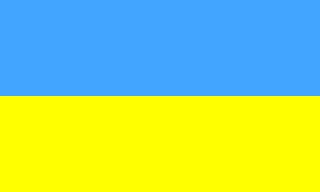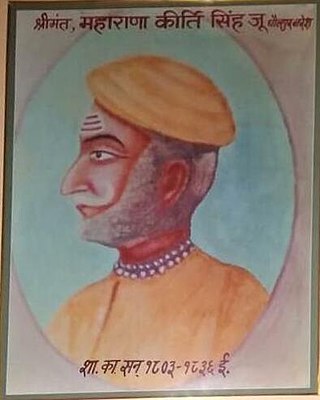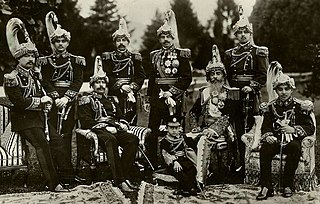Related Research Articles

Chhatri are semi-open, elevated, dome-shaped pavilions used as an element in Indo-Islamic architecture and Indian architecture. They are most commonly square, octagonal, and round.

The Kachhwaha, or Kushwaha is a Rajput clan found primarily in India.

Dhaulpur State or Dholpur State, was a princely state under British suzerainty, in eastern Rajasthan, India, which was founded in AD 1806 by ruler Rana Kirat Singh of Gohad. After 1818, the state was placed under the authority of British India's Rajputana Agency. The Ranas ruled the state until the independence of India in 1947, when the kingdom was merged with the Union of India.

Rao JodhaRathore was the 15th Rajput chief of Rathore clan who ruled the Kingdom of Marwar in the present-day state of Rajasthan. He was the eldest son of Rao Ranmal. He is known for his illustrious military career and for founding the city of Jodhpur in 1459, which subsequently became the new capital of Marwar after Mandore.

Girdhar Pratap Singh Rana was the ruler of Gohad state in Madhya Pradesh, India. He became the ruler of Gohad after the fall of Bhim Singh Rana, who had no son. Girdhar Pratap Singh became his successor in 1755. Girdhar Pratap Singh was the son of Samant Rao Balju, a family friend of Rana Bhim Singh. Girdhar Pratap Singh could not rule Gohad for long as he died in 1757. His successor was Rana Chhatar Singh (1757–1785). He was from Bamraulia caate. He ruled Gohad state until 1757.

Kirat Singh Rana (1763–1835) was a ruler of Gohad state (1803–1805) in Madhya Pradesh, India. He was the founder and first ruler (1805–1835) of Dholpur princely state.

The Rana dynasty was a Chhetri dynasty that imposed authoritarianism in the Kingdom of Nepal from 1846 until 1951, reducing the Shah monarch to a figurehead and making the Prime Minister and other government positions held by the Ranas hereditary. The Rana dynasty is historically known for their iron-fisted rule in Nepal. This changed after the Revolution of 1951 with the promulgation of a new constitution, when power shifted back to the monarchy of King Tribhuvan.

The Fort of Gwalior or the Gwalior Fort is a defence hill fort in Gwalior, India. Mughal Emperor Babur called it the "pearl amongst the fortresses of Hind" because of its impregnability and magnificence and it has also been nicknamed the Gibraltar of India. The history of the fort goes back to the 5th century or perhaps to a period still earlier. The old name of the hill as recorded in ancient Sanskrit inscriptions is Gopgiri. The current structure of the fort has existed at least since the 8th century, and the inscriptions and monuments found within what is now the fort campus indicate that it may have existed as early as the beginning of the 6th century, making it one of India's oldest defence fort still in existence. The modern-day fort, embodying a defensive structure and two palaces was built by the Tomar Rajput ruler Man Singh Tomar. It has witnessed the varying fortunes of the Guptas, the Hunas, the Pratiharas, the Kachhwahas, the Tomaras, the Pathans, the Surs, the Mughals, the English, the Jats, and the Marathas represented by the powerful Scindia dynasty who have left their landmarks in the various monuments which are still preserved.
Indergarh is a town and a nagar parishad in Datia district in the Indian state of Madhya Pradesh.
Rahon is a town and a municipal council in the district Shaheed Bhagat Singh Nagar of the Indian state of Punjab. Rahon is in Doaba region of Punjab. Doaba also known as Bist Doab, is the region of Punjab, India that lies between the Beas River and the Sutlej River. A famous battle was fought here between Sikhs and Mughals i.e Battle of Rahon (1710).

Maharaja Jawahar Singh was the ruler of the Bharatpur State. He succeeded to the throne when his father Maharaja Suraj Mal Ji died in 1763.
Rana Pohap Singh was the ruler of Dholpur state in (1836) in Rajasthan, India. He was from Bamraulia clan. He was the elder son and successor of Rana Kirat Singh. He ruled for nine months and died in 1836. After his death his younger brother Rana Bhagwant Singh ascended to the throne.

The history of human settlement in the western Indian state of Rajasthan dates back to about 100,000 years ago. Around 5000 to 2000 BCE many regions of Rajasthan belonged as the site of the Indus Valley Civilization. Kalibangan is the main Indus site of Rajasthan, here fire altars have been discovered, similar to those found at Lothal.
Utila Fort is a fort in Gwalior district in Madhya Pradesh, India. Utila is 20 kilometres (12 mi) east of Gwalior city on Gwalior–Hastinapur-Behat Road.
Jojawar is a village located in Marwar Junction tehsil of Pali District in Rajasthan State, India. The mountains of the Aravalli Range are very near to this village. Jojawar is the location of the Jawahar Navodaya Vidyalaya school for Pali District, located about 1.5 km away on the Marwar Junction road.

Alwar State is a princely state of Naruka Rajputs with its capital at Alwar in India. Founded in 1770 CE by Pratap Singh Naruka, its reigning ruler, Maharaja Sir Tej Singh Prabhakar Bahadur, signed the accession to the Indian Union on 7 April 1949.
Bhim Singh may refer to:
Events in the year 1707 in India.

Gohad State or Kingdom of Gohad was a kingdom in India. It was established by King Singhadev II in 1505.
References
- ↑ Elliot, Sir Henry Miers (1877). The History of India, as Told by Its Own Historians: The Muhammadan Period. Trübner and Company.
- ↑ Persian Records of Maratha History. 1952.
- ↑ Jackson, Abraham Valentine Williams (1906). History of India: From the reign of Akbar the Great to the fall of the Moghul empire, by S. Lane-Poole. Grolier Society.
- ↑ Agnihotrī, Ajaya Kumāra (1985). Gohada ke Jāṭoṃ kā itihāsa: rājanaitika evaṃ sāṃskr̥tika adhyayana, San 1505 se 1947 taka (in Hindi). Nava Sāhitya Bhavana.